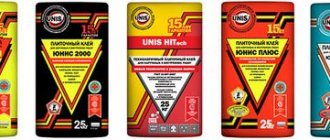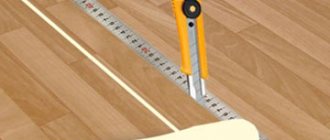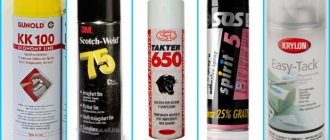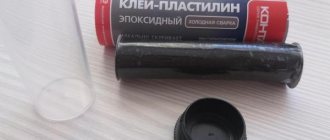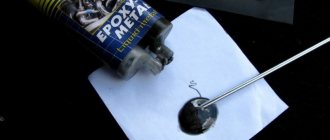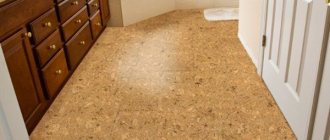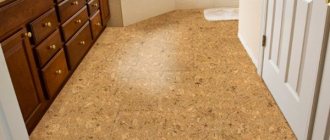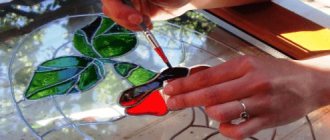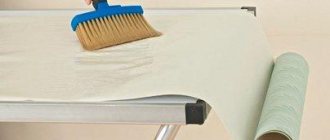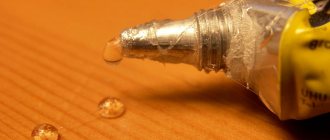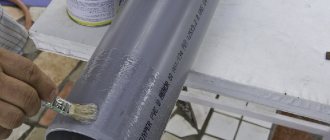Adhesives are often required for repair work at home. They are also used in large enterprises and specialized workshops for joining parts made of different materials. In recent years, spray adhesive has become very popular among home DIYers.
Its main advantage is the ease of application to bonded surfaces.
Description of the spray product
Spray adhesive, available in cans, is used for gluing materials that differ in texture and structure and/or homogeneous surfaces.
The aerosol form of release gives this product some advantages over standard adhesive compositions.
For example, a spray allows you to apply the product in an even and thin layer, which guarantees more economical consumption when treating large areas.
There is no need to purchase additional tools for work (rollers, spatulas, etc.). Seam thickness can be easily adjusted.
It is worth noting separately that the adhesive in aerosol form is practically invisible, since the aerosol composition is transparent and does not leave traces in the form of streaks, smudges and stains.
The spray easily penetrates into hard-to-reach places. If necessary, they can replace double-sided tape.
An additional advantage is the sealed packaging, in which the properties of the aerosol composition are preserved for a long time. The composition of aerosol adhesives is similar to standard products, the only difference being the form of release and ease of use.
Aerosol adhesive is ready to use immediately; there is no need to first pour or squeeze it out of the bottle. Surfaces treated with spray adhesive quickly set and even thin materials do not deform during the drying process.
The ease of application in hard-to-reach places and the high degree of adhesion of the materials in the area make aerosol compositions stand out among cheaper products.
General rules of use
To glue foam rubber, you should consider the following rules:
- Elements must have smooth edges. To do this, the material should be cut with a sharp knife.
- Surfaces to be glued must be dry and clean.
- The glue is applied using a brush or gun.
- Before carrying out work, it is recommended to read the instructions.
- The parts treated with glue are connected and fixed until the substance hardens.
- After this, you need to check the strength of the seam.
Hot weather negatively affects the quality characteristics of adhesives. They thicken quickly, which increases consumption and reduces drying time.
Areas of application of aerosol adhesives
The qualities of adhesive aerosols described above provide a wide range of applications for these products.
Most often such means are used:
- in furniture production - aerosols do an excellent job of holding together foam rubber, fabric, plastic and wooden elements
- in car repair and finishing - for gluing upholstery elements, plastic parts, leather, rubber, installing vibration insulation
- in construction work with artificial materials, with PVC and vinyl panels, with insulation, insulation, as well as aerated concrete and foam blocks
- in everyday life - for sealing seams to protect against leaks, fastening parts made of glass, ceramics and metals
- in creativity - to create a variety of shapes, complex designs and figures using paper, cardboard, foil, polymers and polyethylene.
Composition and characteristics of adhesive aerosols
Like other adhesives, aerosols may contain as a main component rubber diluted with solvents on an organic or other basis, polyurethane, neoprene or butadiene styrene.
They are also available with water-based acrylic resins, ideal for creative applications. Light atomization is provided by the liquefied gas present in the aerosol composition.
Typical properties of aerosol adhesives include:
- short setting time of the aerosol composition, which does not require long-term fixation of parts
- resistance to high temperatures, some compounds are not affected by sub-zero temperatures
- elasticity
- creation of high-strength connections and high degree of adhesion
- UV resistance
- safety and ease of use when working with delicate materials
- resistance to moisture (not all products)
Advantages
Aerosol adhesive has the following advantages:
- Easy to use, as it does not require spatulas, brushes or other tools.
- Fast drying. Thanks to this, long-term fixation of materials is not required.
- Long shelf life due to the tightness of the aerosol can.
- Economical to use, since the time and intensity of pressing can be adjusted.
- Does not stain the materials being fastened.
- Does not destroy acrylic coating.
- Strength and durability.
- It is resistant to elevated temperatures, so you can even glue those places that are exposed to sunlight, for example, window frames.
Types of products depending on the materials being glued
There are aerosol adhesives designed to work with
- smooth materials - film, polypropylene, foil, metals
- fabric and paper materials. Traces of products from this line are invisible on the surface
- rubber. Thanks to the main component of such products - rubber, delamination and drying out of the rubber surface does not occur.
- plastic and metal. Particularly durable compounds that provide high-quality adhesion of materials
- carpet and carpeting. Reduces installation time and is easy to use
- any materials, not necessarily homogeneous. Universal glue.
How to choose the right one
When choosing a spray for high-quality gluing, you need to look at different parameters - composition, characteristics, consumption, cost. Very cheap glue cannot be good, in addition, there is a chance of getting a fake. It is also necessary to look at such indicators as surfaces to be glued, operating temperature, and permissible operating conditions.
The universal gluing spray can be used for:
- Plastic.
- Plywood.
- Polymers.
- Paper, cardboard.
- Ceramic surface.
- Glass.
- Felt.
- Tiles of different types.
- Wooden products.
Operating procedure
To maintain adhesive properties, preliminary surface preparation should be carried out. The process consists of two stages - cleaning and degreasing.
First you need to thoroughly remove all contaminants, then treat the surface with sandpaper and apply solvent or alcohol.
After complete drying, you can begin gluing. Before starting work, the aerosol should be kept at room temperature and shaken well.
To evenly cover the surface, the cylinder should be held parallel to the part at a distance of 0.15-0.2 m.
The second layer is applied 10 minutes after the first. The method of surface treatment depends on various factors.
In particular, for heavy or highly porous parts a thicker layer of glue will be required, for wide objects it will be necessary to apply the composition to all parts and on all sides, while when gluing thin materials it will be enough to apply the glue to one of them.
The complete drying time depends on the type of adhesive composition and averages from half an hour to an hour or more.
To save residues for further work, turn the aerosol over with the spray nozzle down, press it several times, wait until air begins to come out of the container, return the container to a vertical position and close it.
It is recommended to store the product at a temperature of +5 to +30 degrees Celsius out of the reach of children. Keep away from heat and direct sunlight.
Precautionary measures
To ensure that working with aerosol adhesives is safe, the following conditions must be strictly observed:
- carry out all work only in well-ventilated areas
- exposed parts of the body must be protected with protective clothing and gloves. If the product gets on your skin, wash it immediately with soap.
- exclude smoking and any possibility of aerosol composition with fire, as this may lead to the explosion of the container
- To avoid damage to the glue, it is worth storing it separately from acids, alkalis and batteries
- Close the container tightly after use.
Removal methods
There are 2 ways to clean the base from the adhesive mass:
- Wash. The finished item is washed with soap and warm water. When mixed with water, temporary glue loses its qualities and lags behind the surface of the fabric.
- Wiping with a wet cloth. Wash away residue from items that cannot be washed. Adhesive compounds can be easily removed with warm water.
Takter and some other adhesives do not need to be removed to stiffen the canvas when embroidering. Upon contact with air, the mass breaks down into inactive components and gradually evaporates without a trace.
Review of manufacturers
The line of aerosol adhesives includes products of both domestic and foreign production.
Scotch Weld brand products 75 ZM and 77 ZM were highly appreciated by users. These are highly adhesive transparent compounds for working with light and medium weight materials.
For car repairs, Done Deal adhesive based on artificial rubber, propane and butane is often used. The universal aerosol composition allows you to glue parts made of various fabrics, glass, rubber and leather.
Elastic adhesive SinTex, aerosol. which is based on artificial rubber dissolved with non-flammable components, has heat-resistant characteristics and is universal and suitable for working with most materials, in particular felt, spunbond, car carpet and cork.
Allows you to apply the finest adhesive seams. In gluing polystyrene foam, as well as working with many other materials, in particular metal, glass, wood, the adhesive spray “888 Reinforced Fixation”, a universal hydrocarbon product based on synthetic materials, has proven itself to be excellent.
Spray adhesive "ABRO"
Product made in the USA.
It enjoys well-deserved popularity among users thanks to a special nozzle that provides coverage with a very thin layer, as well as a wide range of universal, special, quick-drying and high-strength products.
Aerosol adhesive is a modern product that allows you to save time when solving problems when working with complex surfaces.
The ease of application and reliable bonding provided by adhesive sprays make them an almost unique product.
